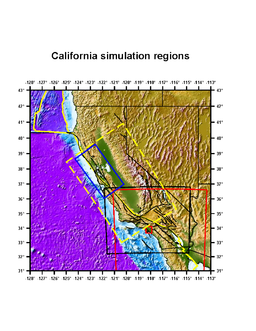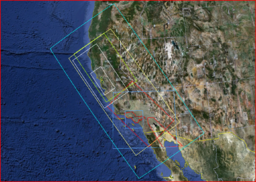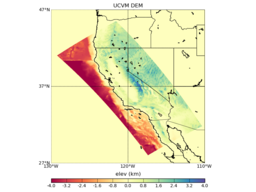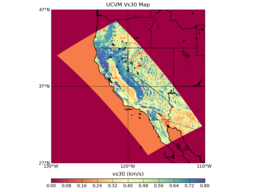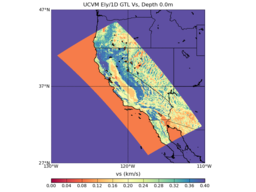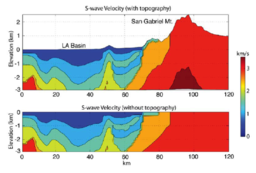Difference between revisions of "UCVM Users Guide"
| Line 242: | Line 242: | ||
| Linux | | Linux | ||
| '''Proj.4 Library 4.7.0 (4 Mb)''' | | '''Proj.4 Library 4.7.0 (4 Mb)''' | ||
| − | | [http:// | + | | [http://hypocenter.usc.edu/research/ucvm/proj-4.7.0.tar.gz]-[<br>(Recommend 4.7.0 since there is a symbol conflict with 4.8.* and CVM-H 11.9.0) |
| N/A | | N/A | ||
|} | |} | ||
| + | *Proj 4 web site: [http://trac.osgeo.org/proj/ PROJ.4 - Cartographic Projection Library] | ||
| − | Supported velocity models: | + | == Supported velocity models: == |
{| class="wikitable" border="1" | {| class="wikitable" border="1" | ||
Revision as of 20:11, 21 June 2013
Unified Community Velocity Model (UCVM) software framework is a collection of software tools designed to provide standard interface to multiple, alternative, California 3D velocity models. One important use of UCVM is in high resolution 3D wave propagation simulations for California. UCVM development is an interdisciplinary research collaboration involving geoscientists and computer scientists. UCVM geoscience research includes identification and assembly of existing California velocity models into a state-wide model and improvements to existing velocity models. UCVM computer science research includes definition of a easy-to-use CVM query interface, integration of regional 3D and geotechnical models, and automated CVM evaluation processing capabilities.
Contents
Existing Model Coverage
UCVM is trying to move forward on a statewide seismic velocity model for CA suitable for ground-motion modeling. Current concept is that this model would not be a single model but a seamless combination of models covering various regions of the state. One complication this approach introduces is how to transition from one model to another and the use of background models to fill in the gaps.
As a first step, we put together a map of the coverage:
Current Detailed Seismic Velocity Models
- SCEC CVM-S4 CVM-S
- SCEC CVM-SI CVM-SI
- SCEC CVM-H CVM-H
- USGS Bay Area Model cencalvm
- Carl Tape's Great Central Valley Model
- Rob Graves' Cape Mendocino Region Model, Graves (1994)
- Harold Magistrale's Wasatch Front Model (Utah)
Background Tomographic Models
- Moschetti Surface Wave Models
- Parkfield regional model, Thurber et al (2006)
- San Francisco area regional model, Thurber et al (2007)
- Northern California Regional 3D P-wave Velocity Model, Thurber et al (2009)
- Egill's regional southern CA model
- California Statewide 3D Velocity Model, Lin et al (2010). wiki: Lin Thurber CVM website: Guoqing Lin's website
Summary of Coverage Regions
Tape is working on a new socal mesh (black) of CVMH6.3 will cover somewhat west and north of the current CVMH model. This is the m16 model region from my thesis, which was based on an older CVMH model. Eventually it will contain the entire CVMH6.3 model, including to the south. All CVMH6.3 simulations are Vp, Vs, rho, with constant attenuation above the basement surface (in the basins). CVMH goes down a couple hundred kms, but the portion I use is upper 60 km, and the local earthquake inversion sensitivity is dominantly upper 25 km.
- The yellow dashed line is the target simulation goal for San Joaquin and Sierra model and simulations. Andreas, John, and Carl have developed several surfaces within this region (including to the continental shelf), and we have lots of velocity data in the San Joaquin basin, which is our focus. (Andreas loaded the Lin-Thurber CA model as well.)
- The red box is CVMH6.3
- The inner red box as the high-res LA model.
- California CVM regions CVM Boundaries in KML format
Model List
SCEC CVM-S
This southern California model is described at CVM-S.
SCEC CVM-SI
This southern California model is described at CVM-SI.
SCEC CVM-H
This southern California model is described at CVM-H.
USGS Bay Area (cencalvm)
This northern California model is described at cencalvm.
Northern California Regional 3D P-wave Velocity Model
Here is info on the first of four of our regional-scale 3D P-wave velocity models that I will provide. This is for our Northern California model, published in Thurber et al (2009).
Formally, the bounding rectangle is approximately given below however, the western edge realistically is the California coastline, and the northern edge is not quite to the Oregon border.
42.60, -122.32 40.34, -126.27 37.74, -117.88 35.62, -121.71
- The bottom nodes of the model are at 36 km.
- Node spacing is mostly 10 or 15 km in the NE-SW direction and is uniformly 20 km in the NW-SE direction. Actual model resolution based on checkerboard tests is nominally ~twice the node spacing.
- Vp model provided.
Cape Mendocino Region Model
This manuscript describes some 3D modeling of the Eel River basin which is in the Cape Mendocino region at the northern end of the San Andreas. Rob Graves did this work as part of the development of the 3D FD methodology and published as a USGS external grant report in Graves (1994).
Parkfield Regional Model
Parkfield regional model, published in Thurber et al. (2006). Bounding box corners:
TOP: 35.918339 -121.412085 36.6838908 -120.320581 BOTTOM: 35.0996582 -120.542912 35.86521 -119.45284
The model is fully documented in the supplementary information for the paper Thurber et al (2006).
San Francisco Regional Model
A higher-resolution model for the San Francisco Bay area, published in Thurber et al (2007). It covers a smaller region than our northern California model so perhaps it is not useful.
Wasatch Front Model (Utah)
This is a Utah Geological Survey velocity model for NE Utah, developed by Harold Magistrale and described at wfcvm.
Overview of CVM Models
These posters and presentations may contain information about earlier versions of CVM-H. This information may be useful to some users.
- Overview of CVM-H 11.2 (1Mb powerpoint file)
- Overview of CVM-H 11.1 (1Mb powerpoint file)
- Andreas Plesch Overview of CVM-H (2008) (7.4Mb powerpoint file)
- CVM-H Poster SCEC Annual Meeting (2008) (1.8Mb pdf file)
- Overview of SCEC Unified Structure Representation (USR) Developments (4.2Mb powerpoint file)
Desired Model Features
There is a set of fundamental information necessary to include any new model into UCVM, regardless of delivery format (files, table in a paper ,etc.). If the new model is already packaged as a downloadable code set, there are a number of features that make it easier for it to be integrated into UCVM. These are listed below.
Fundamental Information
- The map projection/datum used, and the (lon,lat) to (x,y) transformation
- The bounding polygon for each models
- The depth extent, and whether the model is query by depth/elevation/elev_offset
- Brief description of the resolution
- The physical properties it includes (i.e., density, Vp, Vs, Qp, Qs).
Packaging in Code
- Provide both application programming interface and command-line query tool
- Programming interface: C preferred, although C++/Fortran will work, with the following function defined:
- Initialization function
- Query model function
- Get Version ID function
- Finalizer (cleanup) function
- GTL toggle: Allow toggling any GTL on/off in both API and command-line tool
- Allow query by (lon, lat, depth), where depth is offset from free surface, positive down
- Return Vp, Vs, density at a minimum
- Model region has finite extents, outside of which the query function returns a "no data" indicator
- Able to compile model with generic GNU compiler
UCVM Software
A software framework has been developed to support a state-wide model. The framework contains a command-line query tool and a C API for querying any supported velocity model.
Coverage Region and Projection
Projection for 2D Maps
The following is the coverage region and projection for the included 2D elevation and Vs30 maps. The entire state of California is included, along with portions of Oregon, Nevada, Arizona, and northern Mexico.
Origin: -129.75 DD, 40.75 DD Projection: Azimuthal Equidistant (Proj.4 projection string "+proj=aeqd +lat_0=36.0 +lon_0=-120.0 +x_0=0.0 +y_0=0.0") Rotation Angle: 55.0 D Dimensions: 1800km x 900km
- UCVM 2D map versus regional CVM coverage areas UCVM 2D Map Boundaries in KML format
- Extremes of UCERF 2.0 ruptures we would like to include (kml)
Statewide Data Sets
DEM
A statewide DEM for the proposed coverage region is included within UCVM. Elevation data has been sampled from USGS NED 1 arcsec dataset (~30 m), and bathymetric data from the NOAA ETOPO1 1' dataset (~1.5 km). This DEM is currently sampled at a resolution of approximately 220m but this may be increased. The elevation data is stored as a fixed resolution Etree for the entire 1800 x 900 km region. The elevation at a particular point is smoothed using bilinear interpolation of the surrounding four elevation octants.
Vs30 Maps
Two statewide Vs30 maps for the proposed coverage region are included within UCVM:
- Wills-Wald Vs30 map (default): Vs30 data for the California landmass has been sampled from the Wills (2006) dataset at approx 0.0002197 D resolution, and out-of-state/ocean areas have been sampled from the Wald (2007) dataset at 0.0083333 D resolution.
- Yong-Wald Vs30 map (optional): Vs30 data for the California landmass has been sampled from the Yong (2011) dataset at approx 0.013 D resolution, and out-of-state/ocean areas have been sampled from the Wald (2007) dataset at 0.0083333 D resolution.
These maps are currently sampled at a resolution of approximately 220m but this may be increased. The Vs30 data is stored as a fixed resolution Etree for the entire 1800 x 900 km region. The Vs30 value at a particular point is smoothed using bilinear interpolation of the surrounding four map octants.
Geotechnical Layer
A statewide GTL for the proposed coverage region is included within UCVM. This is based on the Vs30-derived GTL method developed by Ely (2010). Interpolation between this GTL and the underlying crustal models is accomplished with the interpolation method described in that same publication. The z range over which interpolation is performed is configurable, as is the interpolation method used. The Ely method takes its input Vs30 value from the Vs30 map included within UCVM (described in the previous section).
Additionally, UCVM is able to support any number of other user-defined GTLs. It will combine them in a manner analogous to how the crustal models are combined. Each GTL may also have its own user-defined interpolation function that is used to blend it with the underlying crustal models. If no interpolation method is specified, linear interpolation is assumed.
Hydrology Map
A statewide hydrology map for the proposed coverage region will be included within UCVM. This map will provide the surface elevations of bodies of water such as oceans, lakes, and seas. No source dataset has been identified as of yet. This map will allow water information to be returned when UCVM is queried by elevation.
Combining Regional Models
The UCVM API currently combines models by simply tiling them in a user-specified order. The software also provides a post-processing "patching" mechanism to smooth out discontinuities at the interfaces between different regional models. The user identifies a 3D geographic region in the form of an open box where smoothing is to be performed. A patcher is run to extract the material properties along the surfaces of this box at a fixed resolution (eg: 250 m) and it saves them into a new model which may then be imported into and queried by UCVM. Points that fall within the smoothing region are interpolated using an inverse distance weighting function with the 10% closest surface points on the same z-plane. A power factor of 2.0 is used for weighting. Linear interpolation is used along the z-axis to smooth out the edge values.
The following series of images show how this process works:
Export to Etree
Any number of regional models and GTLs may be combined into a single meta-model and then exported to an Etree with variable resolution. The local resolution at a particular point is determined with the following relation:
local rez <= local Vs / (fmax * ppw) where: local rez : the local resolution in meters local Vs : the local minimum Vs in meters/sec fmax : desired max frequency to support in Hz ppw : points per wavelength
Documention
The user guide is available at UCVM User Guide.
Download
An official distribution of UCVM is available for download below. It consists of several tarballs: the UCVM framework, the Proj.4 library, the Euclid Etree library, and a collection of velocity models that have been upgraded to work with UCVM. The UCVM, Etree, and Proj.4 software distributions are the minimum required for installation. The UCVM User Guide contains the installation instructions.
Minimum required distributions:
| Platform | File | Download | Mirror |
|---|---|---|---|
| Linux | SCEC UCVM 12.2.0 Official Release (350 Mb) | ucvm-12.2.0.tar.gz | N/A |
| Linux | SCEC UCVM 12.2.0 md5 checksum (< 1Kb) | ucvm-12.2.0.tar.gz.md5 | N/A |
| Linux | CMU Euclid Etree Library 3.1.3 (100 Kb) | euclid3-1.3.tar.gz | N/A |
| Linux | Proj.4 Library 4.7.0 (4 Mb) | [1]-[ (Recommend 4.7.0 since there is a symbol conflict with 4.8.* and CVM-H 11.9.0) |
N/A |
- Proj 4 web site: PROJ.4 - Cartographic Projection Library
Supported velocity models:
| Platform | File | Download | Mirror |
|---|---|---|---|
| Linux | SCEC CVM-H 11.9.1 (550 Mb) | cvmh-11.9.1.tar.gz | N/A |
| Linux | SCEC CVM-S 11.11.0 (v4 with Graves/Ely/Small modifications, 7 Mb) | cvms-11.11.0.tar.gz | N/A |
| Linux | SCEC CVM-SI 11.11.0 Evaluation (includes i0/i5/i8, 4.0 Gb) | cvmsi-11.11.0.tar.gz | N/A |
| Linux | SCEC CVM-NCI 11.11.0 Evaluation (includes i0/i2, 1.5 Gb) | cvmnci-11.11.0.tar.gz | N/A |
| Linux | USGS CenCalVM 0.6.6 w/ Bay Area Models (10 Gb) | cencalvm-0.6.6.tgz USGSBayAreaVM-08.3.0.etree.gz USGSBayAreaVMExt-08.3.0.etree.gz |
N/A |
| Linux | Lin-Thurber Statewide CVM (1.5 Mb) | cvmlt-11.11.0.tar.gz | N/A |
| Linux | Rob Graves Cape Mendocino CVM (<1 Mb) | cvm-cmrg-11.11.0.tar.gz | N/A |
| Linux | Harold Magistrale Wasatch Front CVM (v3c with Small modifications, 3.5 Mb) | wfcvm-11.11.0.tar.gz | N/A |
UCVM Beyond California
The UCVM code base has no specific dependencies upon the state of California. UCVM may be quickly configured for a new region given digital elevation data, Vs30 data, and one or more velocity models. As a proof of concept, this was done for northern Utah (see UCVM Utah) using the Utah Geological Survery Wasatch Front velocity model.
Related Entries
- Collection of Presentations about CVM-S and CVM-H (56Mb ppt file)
- UCVM User Guide
- UCVM API
- UCVM Visualization
- CVM-H
- CVM-S
- Community Velocity Model
See Also
- Harvard Structural Geology & Earth Resources Group
- SCEC CVM
- Geoff Ely Vs30 geotechnical layer implementation
- Qinya Liu Tomography Research
- GuoQing Lin's Research
- USGS CVM Web Site
- Main Page
- SCEC Home Page
References
- Ely, G., T. H. Jordan, P. Small, P. J. Maechling (2010), A Vs30-derived Near-surface Seismic Velocity Model Abstract S51A-1907, presented at 2010 Fall Meeting, AGU, San Francisco, Calif., 13-17 Dec. [Ely2010-AGU.pdf]
- Graves, R. (1994), Rupture History and Strong Motion Modeling of the 1992 Cape Mendocino Earthquake, USGS External Grant Report
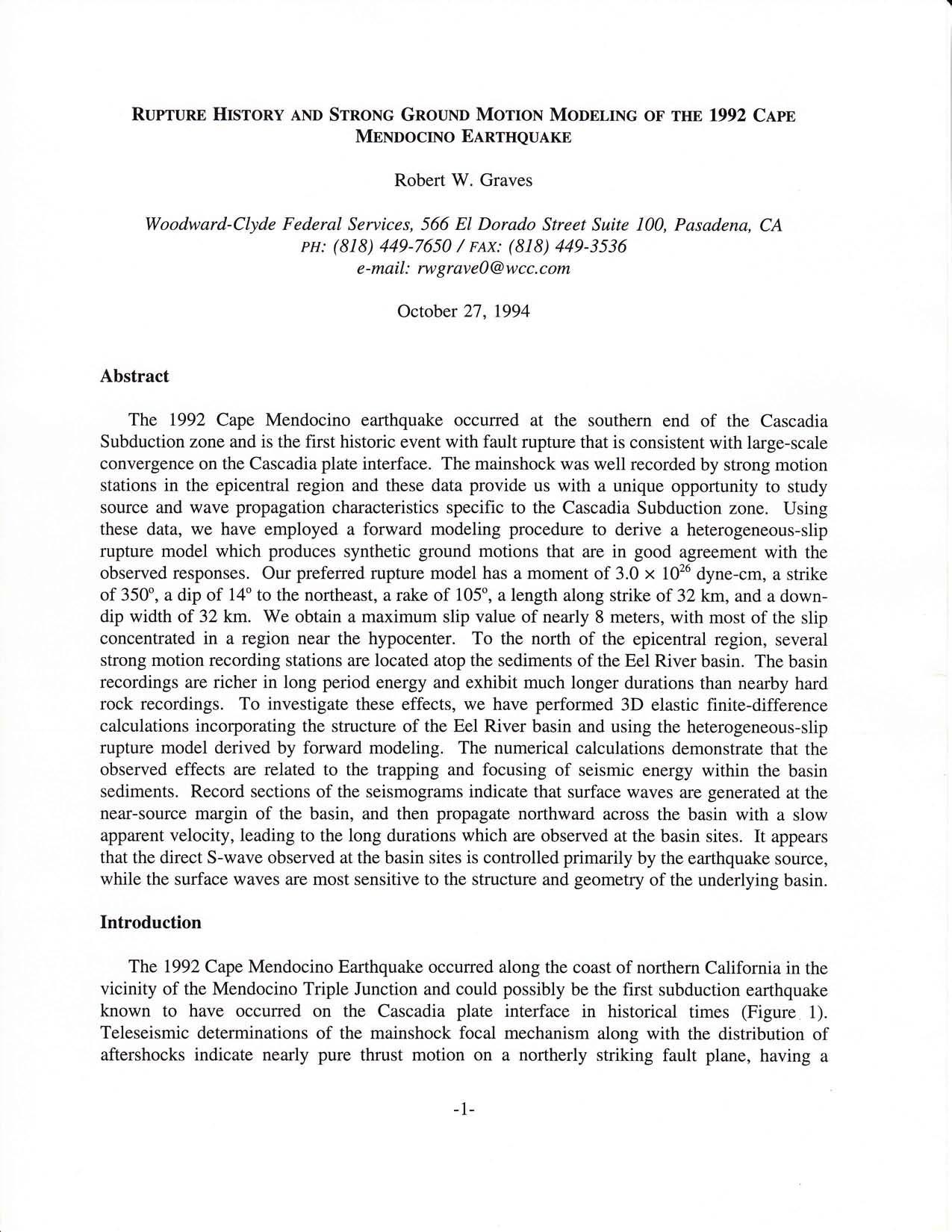
- Lin, G., C. H. Thurber, H. Zhang, E. Hauksson, P. Shearer, F. Waldhauser, T. M. Brocher, and J. Hardebeck (2010), A California statewide three-dimensional seismic velocity model from both absolute and differential Times, Bull. Seism. Soc. Am., 100, in press. supplemental
- Taborda R., López J., O'Hallaron D., Tu T. and Bielak J. (2007), A review of the current approach to CVM-Etrees, SCEC Annual Meeting, Palm Springs, CA, USA, September 8–12. [2]
- Thurber, C., H. Zhang, F. Waldhauser, J. Hardebeck, A. Michael, and D. Eberhart-Phillips (2006), Three-dimensional compressional wavespeed model, earthquake relocations, and focal mechanisms for the Parkfield, California, region, Bull. Seism. Soc. Am., 96, S38-S49, 2006. supplemental
- Thurber, C., T. Brocher, H. Zhang, and V. Langenheim (2007), Three-dimensional P-wave velocity model for the San Francisco Bay region, California, J. Geophys. Res., 112, B07313, doi:10.1029/ 2006JB004682, 2007.
- Thurber, C., H. Zhang, T. Brocher, and V. Langenheim (2009), Regional three-dimensional seismic velocity model of the crust and uppermost mantle of northern California, J.Geophys. Res., 114, B01304, doi:10.1029/2008JB005766, 2009.
- Wald, D. J., and T. I. Allen (2007), Topographic slope as a proxy for seismic site conditions and amplification, Bull. Seism. Soc. Am., 97 (5), 1379-1395, doi:10.1785/0120060267.
- Wills, C. J., and K. B. Clahan (2006), Developing a map of geologically defined site-condition categories for California, Bull. Seism. Soc. Am., 96 (4A), 1483-1501, doi:10.1785/0120050179.
- Yong, A., Hough, S.E., Iwahashi, J., and A. Braverman (2012), A terrain-based site conditions map of California with implications for the contiguous United States, Bull. Seism. Soc. Am., Vol. 102, No. 1, pp. 114–128, February 2012, doi: 10.1785/0120100262.
